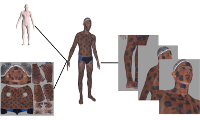From Scans to Models: Registration of 3D Human Shapes Exploiting Texture Information
2015
Ph.D. Thesis
ps
New scanning technologies are increasing the importance of 3D mesh data, and of algorithms that can reliably register meshes obtained from multiple scans. Surface registration is important e.g. for building full 3D models from partial scans, identifying and tracking objects in a 3D scene, creating statistical shape models. Human body registration is particularly important for many applications, ranging from biomedicine and robotics to the production of movies and video games; but obtaining accurate and reliable registrations is challenging, given the articulated, non-rigidly deformable structure of the human body. In this thesis, we tackle the problem of 3D human body registration. We start by analyzing the current state of the art, and find that: a) most registration techniques rely only on geometric information, which is ambiguous on flat surface areas; b) there is a lack of adequate datasets and benchmarks in the field. We address both issues. Our contribution is threefold. First, we present a model-based registration technique for human meshes that combines geometry and surface texture information to provide highly accurate mesh-to-mesh correspondences. Our approach estimates scene lighting and surface albedo, and uses the albedo to construct a high-resolution textured 3D body model that is brought into registration with multi-camera image data using a robust matching term. Second, by leveraging our technique, we present FAUST (Fine Alignment Using Scan Texture), a novel dataset collecting 300 high-resolution scans of 10 people in a wide range of poses. FAUST is the first dataset providing both real scans and automatically computed, reliable "ground-truth" correspondences between them. Third, we explore possible uses of our approach in dermatology. By combining our registration technique with a melanocytic lesion segmentation algorithm, we propose a system that automatically detects new or evolving lesions over almost the entire body surface, thus helping dermatologists identify potential melanomas. We conclude this thesis investigating the benefits of using texture information to establish frame-to-frame correspondences in dynamic monocular sequences captured with consumer depth cameras. We outline a novel approach to reconstruct realistic body shape and appearance models from dynamic human performances, and show preliminary results on challenging sequences captured with a Kinect.
| Author(s): | Bogo, Federica |
| Year: | 2015 |
| Month: | March |
| Department(s): | Perceiving Systems |
| Bibtex Type: | Ph.D. Thesis (phdthesis) |
| School: | University of Padova |
|
BibTex @phdthesis{bogo_phdtesis2015,
title = {From Scans to Models: Registration of 3D Human Shapes Exploiting Texture Information},
author = {Bogo, Federica},
school = {University of Padova},
month = mar,
year = {2015},
doi = {},
month_numeric = {3}
}
|
|


